About
Topics
Energy formsEnergy conversion
Takeaways:
Energy makes changes and movement possible in everyday lifeEnergy is required to enable things to work or move.
There are different forms of energy and they can be converted from one form to another.
Description
This simulation allow students to explore the concepts of kinetic energy and potential energy. When the re-bounce case is selected, the sum of kinetic energy and potential energy drop immediately after each contact with the ground. The energy loss is typically associated with sound and heat energy loss to the surrounding by the ball.Sample Questions that this simulations was made to address
Sample Learning Goals
**Recognise and give examples of the various forms of energy. - kinetic energy - potential energy**Investigate energy conversion from one form to another and communicate findings.
Version:
- http://weelookang.blogspot.sg/2014/09/ejss-projectile-customized-after.html
- http://weelookang.blogspot.sg/2014/08/brown-bag-in-time-in-tune-lunch-time.html
- http://weelookang.blogspot.sg/2014/05/ejss-projectile-motion-model-for.html
- http://weelookang.blogspot.sg/2013/12/ejss-free-fall-model.html
ball taken from: http://psychology.wikia.com/wiki/File:Soccer_ball.svg
http://weelookang.blogspot.sg/2014/09/ejss-projectile-customized-after.html
http://weelookang.blogspot.sg/2013/12/ejss-free-fall-model.html sound effects from http://www.freesfx.co.uk/sfx/bouncing
For Teachers
Teacher-Submitted Activities
|
Title |
Authors |
Level |
Type |
Updated |
Share an activity! email
Translations
| Code | Language | Translator | Run | |
|---|---|---|---|---|
 |
||||
Credits

This email address is being protected from spambots. You need JavaScript enabled to view it.; Tan Seng Kwang slighted edited
Sample Learning Goals


For Teachers
Activity 1
INVESTIGATE
Go to the following simulation: http://tinyurl.com/ast2016-3 
The left panel shows a football being given an initial velocity. This could be zero (the ball is being dropped), upwards (tossed up) or horizontal (thrown horizontally).
The right panel allows you to plot the energy of the object over time. The default is a plot for kinetic energy (ke), but you can also request potential energy (pe), and total energy (te). Remember that you can play the simulation by clicking the appropriate button (►). Click the pause button ( ▌▌) to pause the simulation.
- First select the “free_fall” setting, using the yellow drop-down box in the bottom panel. Watch the ke and pe graphs as the object moves. What do you notice about the graphs?
- suggested answer: kinetic energy increases from t = 0 , KE = 0 J at an increasing rate. Potential energy decreases from t = 0 s, PE = maximum J at an decreasing rate as shown in the sketch.
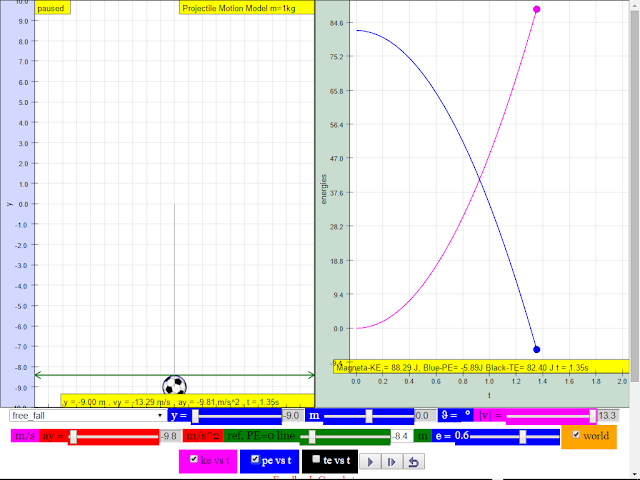
- suggested answer: kinetic energy increases from t = 0 , KE = 0 J at an increasing rate. Potential energy decreases from t = 0 s, PE = maximum J at an decreasing rate as shown in the sketch.
- Now try the “toss_up” setting. How are the ke and pe graphs different?
- suggested answer: kinetic energy decreasing from t = 0 , KE = 50 J at an decreasing rate until t =1 s. From t >1 s, Kinetic energy increases at an increasing rate. Potential energy increases from t = 0 s to 1 s. From t>1 s, PE decreases at decreasing rate as shown in the sketch.
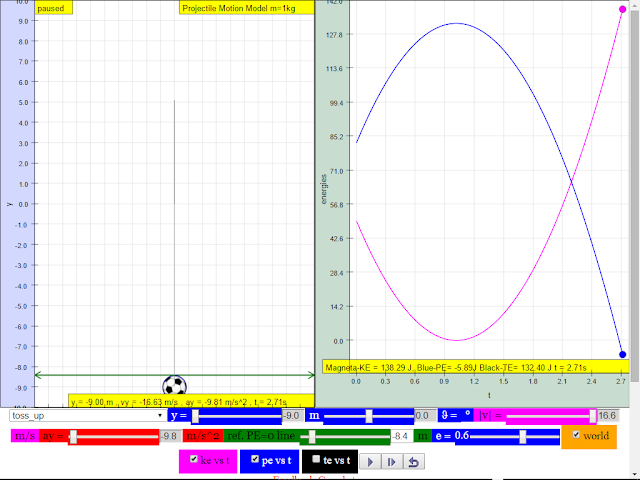
- suggested answer: kinetic energy decreasing from t = 0 , KE = 50 J at an decreasing rate until t =1 s. From t >1 s, Kinetic energy increases at an increasing rate. Potential energy increases from t = 0 s to 1 s. From t>1 s, PE decreases at decreasing rate as shown in the sketch.
- Select total energy te checkbox, suggest an big idea relating ke and pe to te.
- suggested answer: ke + pe = te
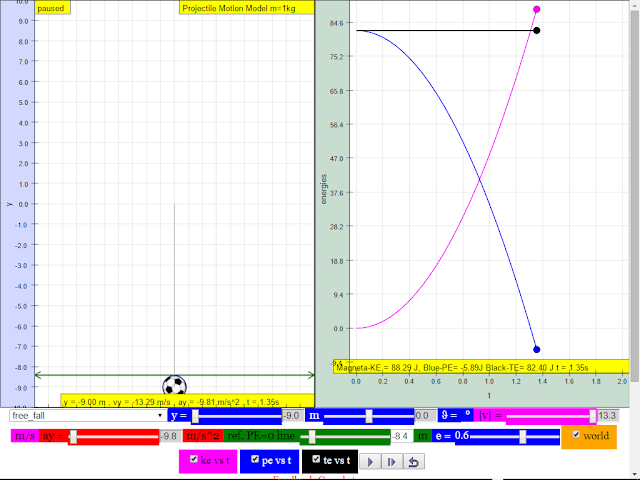
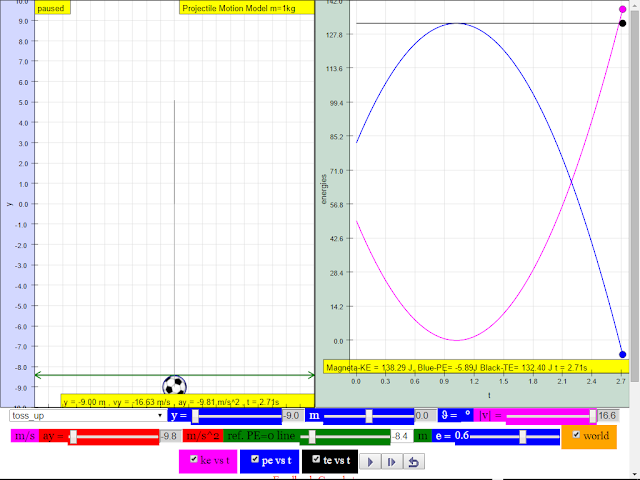
- suggested answer: ke + pe = te
- You can alter the reference line for this simulation. Reset the simulation for “free_fall” or for “toss_up” but, before you press play, change the “ref. PE=0 line” to a different value.
How are the ke and pe graphs different when you choose a different PE reference line?- suggested answer: reference PE = 0 is a imaginary line for which potential energy is calculated referencing from. ke is not affected by “ref. PE=0 line”
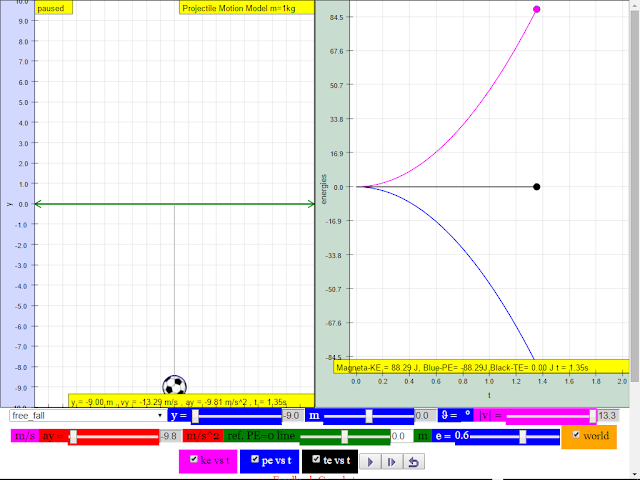

- suggested answer: reference PE = 0 is a imaginary line for which potential energy is calculated referencing from. ke is not affected by “ref. PE=0 line”
MODEL
You may have noticed that the kinetic energy ke depends on the speed |v|. Now set the simulation to “user_defined”. You can choose the speed you want by typing the value in the magenta box in the bottom. You can read the corresponding kinetic energy ke in the yellow box below the graph in the right-hand panel. Try to fill up the table below.
| Speed |v| in m/s | Speed x Speed (v2) | Kinetic energy ke in J |
|
0.00
|
||
|
1.00
|
||
|
2.00
|
||
|
3.00
|
9.00 | |
|
4.00
|
||
|
5.00
|
12.5 |
Now that you have investigated some of the different motions of the football, let’s try to model this by creating some rules about pe and ke. Note that the mass of the ball in the simulation is 1.00 kg, as indicated in the yellow box above the image on the left.
by observing the data is the table, suggest a viable equation-model for ke in terms of v.
suggested answer ke = 0.5*v^2
- Write down some rules for the relationships between pe and ke. Here’s an example:
ke + pe = te
the value of pe is measured from the PE reference line
“The graph for ke does not depend on the PE reference line.”
APPLY
Now try to test your model to see if your rules hold true for a different pre-set motion: “free_fall_and_rebounce”.
- Which of your rules are still the same after trying the “free_fall_and_rebounce” setting?
- ke +pe = te
- the value of pe is measured from the PE reference line
- Which of the rules were not retained?
- ??, ke = 0.5*v^2 is incomplete, the complete equation is ke = 0.5*m*v^2 where m is the mass of the object.
Worksheets
-
Research
[text]
Video
Version:
Other Resources
[text]
Project related:
Understanding Teacher Learning Community as Support for Implementation of Open Source Physics for Conceptual Instruction
Project Number: OER 10/15 GWF
Project Duration: 01 July 2015 - 30 April 2017
http://weelookang.blogspot.sg/2015/07/understanding-teacher-learning.html
end faq
{accordionfaq faqid=accordion4 faqclass="lightnessfaq defaulticon headerbackground headerborder contentbackground contentborder round5"}
- Details
- Parent Category: 04 Energy & Fields
- Category: 07 Energy Work Power
- Hits: 5603







